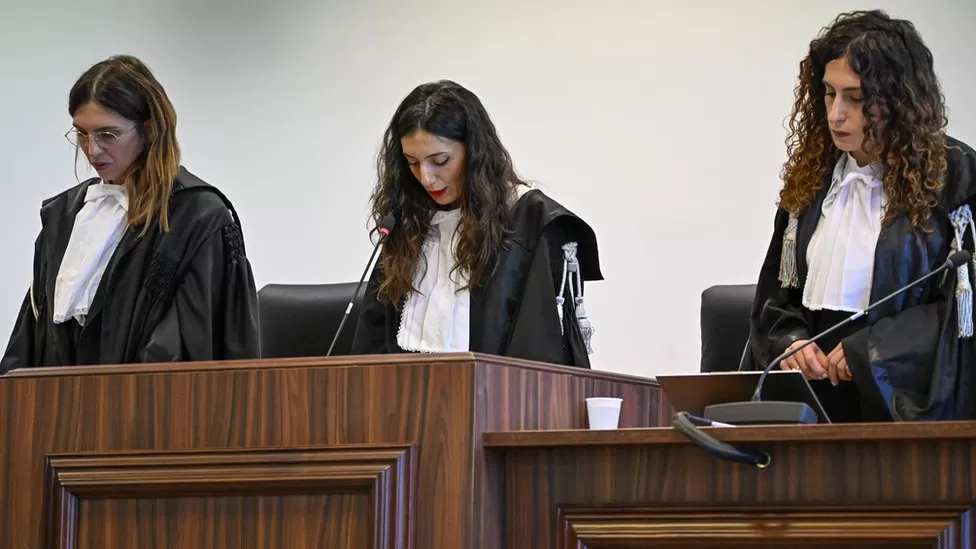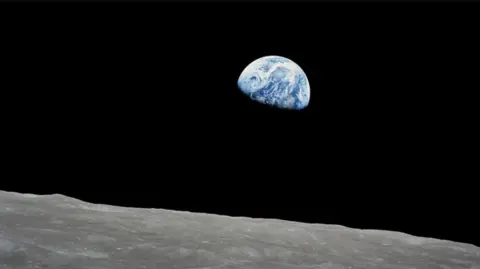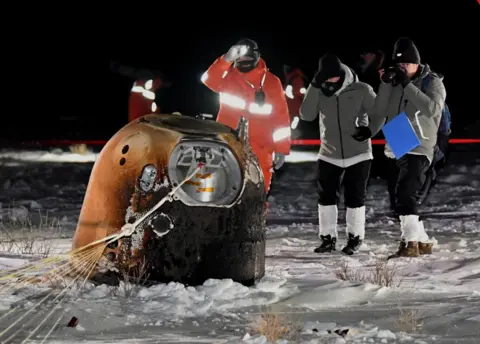Foreign News
Italy mafia trial: 200 sentenced to 2,200 years for mob links

More than 200 defendants in one of Italy’s biggest mafia trials for generations have been sentenced to a total of more than 2,200 years in jail.
The three-year trial saw individuals allegedly linked to the ‘Ndrangheta sentenced for crimes ranging from extortion to drug trafficking. Those sentenced included a former Italian senator, though the verdicts can still be appealed.
The ‘Ndrangheta is one of Europe’s most influential criminal organisations.
The case illustrated the mob’s broad influence over the politics and society of southern Italy. Experts said the convictions of white collar workers, including local officials, businessmen and politicians, showed the far-reaching impact of organised crime on Italian institutions.
Among the most notable people to be sentenced was Giancarlo Pittelli, a lawyer and former senator for ex-premier Silvio Berlusconi’s party Forza Italia. Pittelli received an 11-year sentence for collusion with a mafia-type organisation.
Others convicted included civil servants, professionals across various industries and high-ranking officials, who were critical to the ‘Ndrangheta’s success in infiltrating the legitimate economy and state institutions.
More than 100 defendants were acquitted.
The judges presiding over the case were put under police protection over fears for their safety.
Originating in the impoverished region of Calabria, the ‘Ndrangheta is considered one of the world’s most dangerous criminal organisations. It is estimated to control as much as 80% of Europe’s cocaine market.
The gang boasts an estimated annual turnover of around $60bn (£49bn).
The trial was held in a call centre on the outskirts of the town of Lamezia Terme, converted into a high-security courtroom equipped with cages to hold the defendants and large enough to hold some 600 lawyers and 900 witnesses. Charges included murder, extortion, drug-trafficking, loan sharking, abuse of office and money laundering.
Over three years, proceedings demonstrated how the Calabrian syndicate extended its reach across continents, eventually operating as far afield as South America and Australia. Its members infiltrated the local economy, public institutions, and even the health system, rigging public tenders and bribing local officials.
The trial, the largest of its kind since the 1980s, saw judges examine thousands of hours of testimony. Former mobsters turned collaborators with the justice system testified about the activities of the Mancuso family and their associates, who wield extensive control over the province of Vibo Valentia.
The Mancuso family, from the town of Limbadi, are one of the most powerful of the 150 clans which make up the ‘Ndrangheta.
Anna Sergi, a professor of criminology at the University of Exeter, said: “This trial confirms convictions of classic mafiosi, sentenced for offences traditionally more associate with criminal activities, such as extortion or drug trafficking.”
She added: “However, it is important to note how the different types of people involved, including white collar workers, provide a more comprehensive view of the entire province and the connections between various mafia clans.”
Most of the defendants were arrested in December 2019, following an extensive investigation spanning at least 11 Italian regions, which began in 2016. Approximately 2,500 officers took part in raids targeting suspects in Vibo Valentia, an area primarily controlled by the ‘Ndragheta’s Mancuso clan.
More than 50 former mafia members agreed to cooperate with the trial, among them Luigi Mancuso’s nephew, Emanuele.
Their testimony shed light on the inner workings of one of Italy’s most powerful mobs. The trial revealed that ‘Ndrangheta members allegedly concealed weapons in cemetery chapels, used ambulances for drug transportation and diverted public water supplies to grow marijuana.
Those who opposed the organised crime group faced grim consequences, including finding dead puppies and goat heads left in front of their houses, torched cars and vandalised shop windows.
“This first round of sentences demonstrates how challenging it is to combat the ‘Ndrangheta due to its political, economic, and financial connections,” Antonio Nicaso, a writer and organised crime expert, said.
(BBC)
Foreign News
Nasa ‘Earthrise’ astronaut dies at 90 in plane crash

Apollo 8 astronaut Bill Anders, who snapped one of the most famous photographs taken in outer space, has died at the age of 90.
Officials say a small plane he was flying crashed into the water north of Seattle, Washington.
Anders’ son Greg confirmed that his father was flying the small plane, and that his body was recovered on Friday afternoon. “The family is devastated. He was a great pilot. He will be missed,” a statement from the family reads.
Anders – who was a lunar module pilot on the Apollo 8 mission – took the iconic Earthrise photograph, one of the most memorable and inspirational images of Earth from space.
Taken on Christmas Eve during the 1968 mission, the first crewed space flight to leave Earth and reach the Moon, the picture shows the planet rising above the horizon from the barren lunar surface.
Anders later described it as his most significant contribution to the space programme.

The image is widely credited with motivating the global environmental movement and leading to the creation of Earth Day, an annual event to promote activism and awareness of caring for the planet.
Speaking of the moment, Anders said: “We came all this way to explore the Moon, and the most important thing that we discovered was the Earth.”
Officials said on Friday that Anders crashed his plane around 11:40PDT (1940BST).
The US National Transportation Safety Board (NTSB) said the 90-year-old was flying a Beechcraft A A 45 – also known as a T-34. The agency said that the plane crashed about 80ft (25m) from the coast of Jones Island.
Anders also served as the backup pilot to the Apollo 11 mission, the name of the effort that led to the first Moon landing on July 24, 1969.
Following Anders’ retirement from the space programme in 1969, the former astronaut largely worked in the aerospace industry for several decades. He also served as US Ambassador to Norway for a year in the 1970s.
But he is best remembered for the Apollo 8 mission and the iconic photograph he took from space.
“In 1968, during Apollo 8, Bill Anders offered to humanity among the deepest of gifts an astronaut can give. He traveled to the threshold of the Moon and helped all of us see something else: ourselves,” Nasa Administrator Bill Nelson said in a statement.
Mark Kelly, a former astronaut who now serves as a US Senator for the state of Arizona, said in a post on X, formerly Twitter, that Anders “inspired me and generations of astronauts and explorers. My thoughts are with his family and friends”.
[BBC]
Foreign News
China’s Chang’e-6 lifts off from far side of Moon with rock samples

A Chinese spacecraft carrying rock and soil samples from the far side of the Moon has lifted off from the lunar surface to start its journey back to Earth, according to state media.
The achievement on Tuesday is a world first and the latest leap for Beijing’s decades-old space programme, which aims to send a crewed mission to the Moon by 2030.
The Xinhua News Agency, citing the China National Space Administration (CNSA), said that the ascender of the Chang’e-6 probe took off at 7:38am local time on Tuesday (23:38 GMT) and entered a preset orbit around the moon.
It described the move as “an unprecedented feat in human lunar exploration history”.
The Chang’e-6 probe was launched last month and its lander touched down on the far side of the Moon on Sunday. It used a drill and robotic arm to dig up soil on and below the Moon’s surface, according to Xinhua.
After successfully gathering its samples, the Chang’e-6 unfurled China’s national flag for the first time on the far side of the Moon, it said.
The agency cited the CNSA as saying that the spacecraft stowed the samples it had gathered in a container inside the ascender of the probe as planned.
[Aljazeera]
Foreign News
China says its spacecraft lands on Moon’s far side

China says its uncrewed craft has successfully landed on the far side of the Moon – an unexplored place almost no-one tries to go.
The Chang’e 6 touched down in the South Pole-Aitken Basin at 06:23 Beijing time on Sunday morning (22:23 GMT Saturday), the China National Space Administration (CNSA) said.
Launched on 3 May, the mission aims to collect precious rock and soil from this region for the first time in history. The probe could extract some of the Moon’s oldest rocks from a huge crater on its South Pole.
The landing was fraught with risks, because it is very difficult to communicate with spacecraft once they reach the far side of the Moon. China is the only country to have achieved the feat before, landing its Chang’e-4 in 2019.
After launching from Wenchang Space Launch Center, the Chang’e 6 spacecraft had been orbiting the Moon waiting to land. The lander component of the mission then separated from the orbiter to touch down on the side of the Moon that faces permanently away from Earth.
During the descent, an autonomous visual obstacle avoidance system was used to automatically detect obstacles, with a visible light camera selecting a comparatively safe landing area based on the brightness and darkness of the lunar surface, the CNSA was quoted as saying by state-run Xinhua news agency.
The lander hovered about 100m (328ft) above the safe landing area, and used a laser 3D scanner before a slow vertical descent. The operation was supported by the Queqiao-2 relay satellite, the CNSA said.
Chinese state media described the successful landing as an “historic moment”. The state broadcaster said “applause erupted at the Beijing Aerospace Flight Control Center” when the Chang’e landing craft touched down on the Moon early on Sunday morning.
The lander should spend up to three days gathering materials from the surface in an operation the CNSA said would involve “many engineering innovations, high risks and great difficulty”. “Everyone is very excited that we might get a look at these rocks no-one has ever seen before,” explains Professor John Pernet-Fisher, who specialises in lunar geology at the University of Manchester.
He has analysed other lunar rock brought back on the American Apollo mission and previous Chinese missions. But he says the chance to analyse rock from a completely different area of the Moon could answer fundamental questions about how planets form.
Most of the rocks collected so far are volcanic, similar to what we might find in Iceland or Hawaii. But the material on the far side would have a different chemistry . “It would help us answer those really big questions, like how are planets formed, why do crusts form, what is the origin of water in the solar system?” the professor says.
The mission aims to collect about 2kg (4.4lb) of material using a drill and mechanical arm, according to the CNSA.
The South Pole–Aitken basin, an impact crater, is one of the largest known in the solar system.
From there, the probe could gather material that came from deep inside the lunar mantle – the inner core of the Moon – Prof Pernet-Fisher says.
The Moon’s South Pole is the next frontier in lunar missions – countries are keen to understand the region because there is a good chance it has ice.

The capsule in the last Chinese moon mission, Chang’e 5, brought back soil and rocks in 2020 (BBC)
Access to water would significantly boost the chances of successfully establishing a human base on the Moon for scientific research.
If the mission succeeds, the craft will return to Earth with the precious samples on board a special return capsule.
The material will be kept in special conditions to try to keep it as pristine as possible.
Scientists in China will be given the first chance to analyse the rocks, and later researchers around the world will be able to apply for the opportunity too.
This is the second time China has launched a mission to collect samples from the Moon.
In 2020 Chang’e 5 brought back 1.7kg of material from an area called Oceanus Procellarum on the Moon’s near side.
China is planning three more uncrewed missions this decade as it looks for water on the Moon and investigates setting up a permanent base there.
Beijing’s broader strategy aims to see a Chinese astronaut walk on the moon by around 2030.
The US also aims to put astronauts back on the moon, with Nasa aiming to launch its Artemis 3 mission in 2026.
(BBC)






















